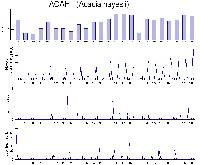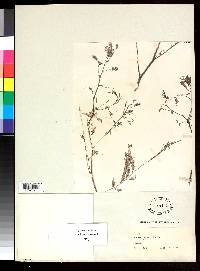
Neotropical Flora
|
Family: Fabaceae
[Acacia acanthophylla (Britton & Rose) Standl.] |
Large canopy liana; trunk to 12 cm diam near the ground, with prominent raised horizontal lenticels; all but the smallest woody parts glabrous, +/- 5-sided, the angles with prominent retrorse prickles. Leaves 30-60 cm long, bipinnate with 9-14 pairs of pinnae, each pinna 6-24 cm long; petiole and rachis puberulent; petioles bearing 1 or 2 round or oblong, sessile glands; rachis canaliculate above, often aculeate below, with glands at the nodes; leaflets in 20-30 pairs per pinna, oblong, blunt at apex, truncate and very inequilateral at base, mostly 9-14 mm long, ca 2.5 mm wide, glabrate to pubescent especially below, the trichomes appressed or erect. Inflorescences large terminal panicles of pedunculate spikes; peduncles 1-2 cm long, puberulent; spikes 10-12 mm long, dense; flowers glabrous, subsessile, greenish; calyx cupulate, ca 2 mm long, as broad as long; corolla cylindric-campanulate, ca 4 mm long; stamens numerous, 7-8 mm long. Legumes thin, linear to oblong, 15-24 cm long, 2.5-3.5 cm wide, softly puberulent, acute or acuminate apically, rounded at base, the margins markedly raised, the surface broadly undulate; seeds +/- disk-shaped, 7-8 mm diam, dark, displayed against the light inner valve surface, borne on a slender funiculus to 13 mm long. Croat 6202. Common within the forest, generally in the canopy, but the leafy branches may occasionally be seen at lower levels where the vine has fallen. Elsewhere this species becomes a tree (fide Flora of Panama), but on BCI its habit is always decidedly vinelike. Flowers in late October and November. The fruits develop to more or less mature size by late January and are dispersed throughout the rest of the dry season and early rainy season (to early May). Plants lose their leaves during the dry season. Lianas climbing into canopy; trunk and branches sulcate, generally glabrous, the ribs (3) 4 (to several), pubescent, armed with prickles, the prickles numerous, 3-5 mm long, broad-based, recurved. Leaves bipinnate with 4-9 pairs of pinnae; rachis and petiole glabrous to puberulent, usually armed and sometimes with many slender stalked glands ca 0.5 mm long, the glands sometimes at nodes on rachis; leaflets in 8-25 pairs per pinna, oblong-elliptic, oblique, acute to +/- rounded and apiculate at apex, truncate at base and attached at a corner, 8-14 mm long, 1.5-4 mm wide, the margins entire or sparsely ciliate. Flowers in short, paniculate spikes; calyx and corolla glabrous. Legumes tan, 15-20 cm long, ca 3.5 cm wide, flat. Croat 15568. The flower and fruit description given here is taken from the Flora of Guatemala (Standley & Steyermark, 1946). BCI vegetative material differs from the descriptions of other authors by having larger leaflets (to 14 mm long and 4 mm wide, compared to 10 mm long and 2 mm wide). |
Powered by Symbiota.




